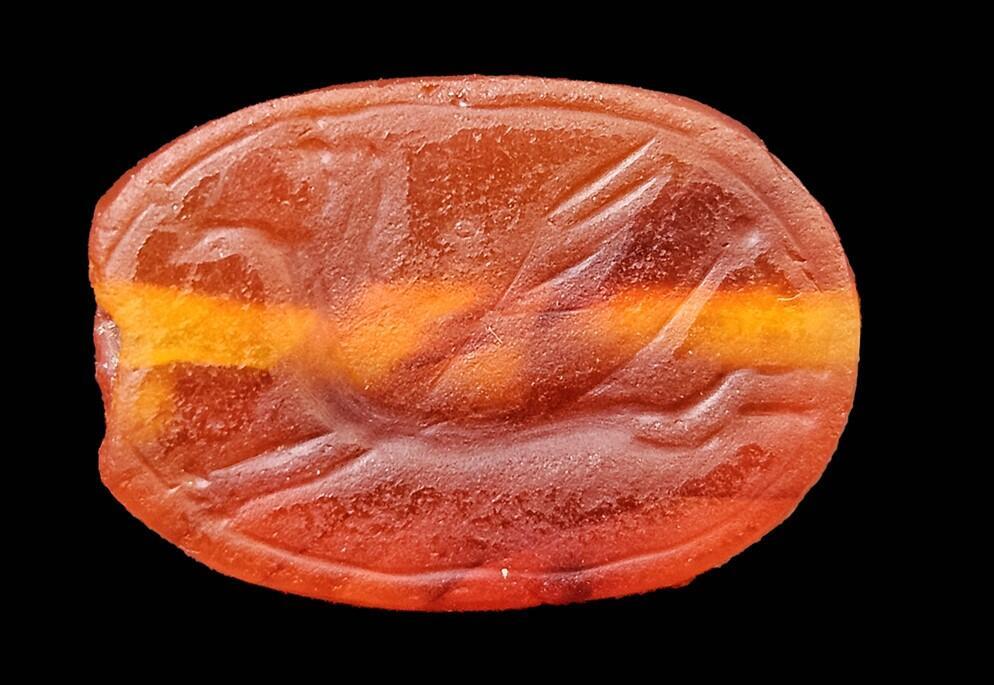Erez Abrahamov, a 45-year-old resident of the West Bank settlement of Pedu'el, found a scarab dating back to the era of the First Temple, around 2,800 years ago on a walk near the Tavor Stream Nature Reserve in the lower Galilee.
Read more:
"I had a two-day leave from my reserve service and decided to take advantage of these sunny days," Avrahamov said. "I saw something sparkling in the ground and at first I thought it was a bead or a shiny stone but after when I picked it up, I noticed that it had carvings that reminded me of a scarab. I reported this amazing finding to the Antiquities Authority."
"Erez called me, and it was clear he had stumbled upon something extraordinary," Nir Distelfeld an inspector from the Antiquities Authority, said. "I asked him to examine the other side of the seal - the flat side, for any engravings. No sooner than I had said that, I heard gasps of wonder over the phone, and he informed me he could make out the name of a figure."
Professor Emeritus Othmar Keel from the Swiss University of Fribourg shared his insights on the find: "The scarab, crafted from a semi-precious stone known as carnelian, bears the image of a Griffin (a creature from mythology) or a winged horse in mid-flight. Seals of a similar nature have been traced back to the 8th century BCE."
"Among the most significant relics at the mound dates back to the Iron Age (6th-7th centuries BCE). In that era, a grand fortress was situated at the peak of the mound. Within it distinctive bathing facilities, halls, and ritual chambers, were discovered, all traced back to Assyrian rule. It is well known that this rule led to the fall of the Kingdom of Israel," said Dr. Eitan Paz, an archaeologist from the Antiquities Authority who had excavated the Tel Rekhesh archaeological site, located south of the Sea of Galilee.
"The scarab that was recently discovered at Tel Rekhesh may belong to the period of the Assyrian rule and possibly indicates the presence of Assyrian (or perhaps Babylonian) officials at Tel Rekhesh during this time. The griffin that appears on the seal is a known artistic motif in ancient Eastern art and is common on seals from the Iron Age,: he said.
"Given the scarcity of findings so far in the fortress area, and if indeed the seal can be dated - based on artistic aspects, to the late Iron Age, there might be a possibility to link the seal with the Assyrian presence in the fortress of Tel Rekhesh, which could be a significant discovery!"
2 View gallery


Beautiful engraving on the amulet
(Photo: Anastasia Shapiro, Israel Antiquities Authority)
The scarab, a seal widely used in the ancient world, was typically fashioned in the likeness of a dung beetle. Its name in Egyptian is derived from the verb meaning "to manifest" or "to be created", symbolizing the Egyptians' view of the scarab as an embodiment of the creator deity.
Scarabs were crafted from a broad array of stones, including semi-precious ones such as amethyst and carnelian. However, the majority of scarabs were made from steatite, a soft talc stone, and were often glazed with a blue-green finish. This glaze could only endure the arid climate of Egypt, so the scarabs found in Israel rarely retain any traces of glaze, and their original stone color tends to be a greyish-white. In contrast to this, the scarab's orange color is quite striking.
"We extend our thanks to Erez for his exemplary citizenship in delivering this rare scarab to the national treasury. In recognition of his commendable act, we have awarded him a certificate from the Antiquities Authority. Undoubtedly, a rare discovery like this can significantly enrich our understanding of history," Distelfeld said.



